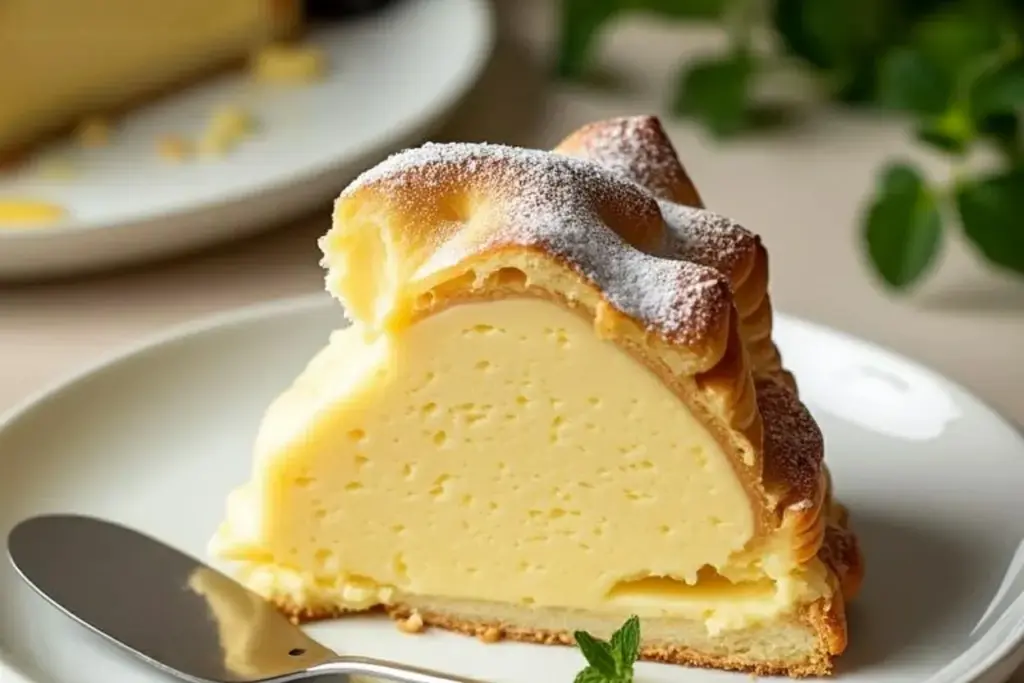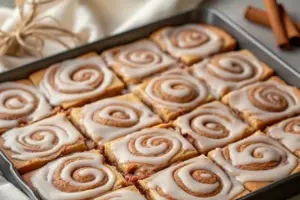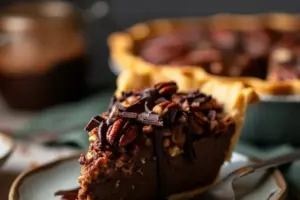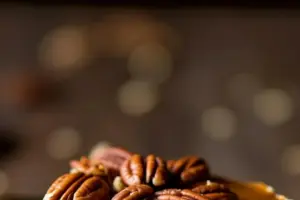If you’ve never tried Karpatka cake, you’re in for a treat. Imagine biting into layers of light, golden choux pastry cradling a thick, luscious vanilla custard cream. It’s like a hug from your dessert plate! This classic Polish dessert has been a beloved staple for generations, and once you try it, you’ll see why. With its signature “mountainous” appearance and melt-in-your-mouth flavors, Karpatka cake is as much a feast for the eyes as it is for the taste buds.
Whether you’re hosting a dinner party, celebrating a special occasion, or just craving something extra indulgent, this recipe is both approachable and impressive. Plus, it’s a great way to explore a little piece of Polish culinary heritage. Let’s dive into the magic of Karpatka cake!
The Story Behind Karpatka Cake
Karpatka cake is often affectionately referred to as “mountain cake” in Poland, thanks to the uneven, rugged look of the choux pastry layers. The name “Karpatka” is derived from the Carpathian Mountains, which the cake’s surface is said to resemble. This dessert is a close cousin to French éclairs or cream puffs but with a unique twist that makes it distinctly Polish.
Growing up, this cake was a showstopper at family gatherings. My grandmother would make it for Easter, Christmas, and sometimes “just because.” The light, airy texture of the pastry paired with the rich and creamy filling feels like the perfect balance. It’s no wonder this dessert has stood the test of time—it’s a recipe passed down through generations, with each family adding their little tweaks.
While traditionally reserved for special occasions, Karpatka cake has become more accessible in recent years. Many home bakers enjoy making it for its simplicity and the joy it brings to anyone lucky enough to snag a slice. Trust me, once you try it, you might find yourself looking for excuses to make it again and again!
Let’s Talk Ingredients
Every ingredient in Karpatka cake plays an important role in achieving its signature texture and flavor. Here’s what you’ll need:
For the Choux Pastry Layers:
- Butter: Unsalted butter is best for controlling the salt level. It gives the pastry its richness and helps create that delightful puff.
- Water: Essential for steaming the dough as it bakes, which creates the airy pockets.
- Flour: All-purpose flour works perfectly. Sift it to avoid lumps in your dough.
- Eggs: They give the pastry structure and help it rise. Use room-temperature eggs for best results.
For the Custard Filling:
- Milk: Whole milk gives the custard a creamy texture. You can substitute with 2%, but avoid skim milk.
- Sugar: Granulated sugar sweetens the filling without making it overly rich.
- Butter: Adds a silky smoothness to the custard.
- Vanilla Extract: The key to that heavenly aroma. Use pure vanilla extract if possible.
- Cornstarch: Thickens the custard perfectly. If you don’t have cornstarch, try potato starch as a substitute.
If you’re feeling adventurous, you can add a pinch of cinnamon or lemon zest to the custard for a unique twist. Just keep in mind that simplicity is the hallmark of this dessert, so don’t overcomplicate it.
Equipment You’ll Need
Making Karpatka cake doesn’t require fancy gadgets, but having the right tools can make the process smoother:
- Medium Saucepan: For preparing the choux pastry dough.
- Whisk: Essential for achieving a lump-free custard.
- Electric Mixer: Optional but helpful for making the custard filling extra creamy.
- 9×13-inch Baking Pan: The perfect size for this recipe. If you don’t have one, you can use two smaller pans and bake the layers separately.
- Parchment Paper: To prevent sticking and ensure easy release of the pastry layers.
Pro tip: Keep a damp towel or silicone mat under your mixing bowl to keep it steady while whisking or mixing.
How to Make Karpatka Cake
- Preheat the oven: Set it to 375°F (190°C). Line your baking pan with parchment paper.
- Make the choux pastry: In a medium saucepan, combine 1 cup (240 ml) water and 1/2 cup (113 g) butter. Heat until the butter melts and the mixture starts to boil. Remove from heat, add 1 cup (125 g) flour, and stir vigorously until it forms a ball.
- Add the eggs: Let the dough cool for a minute, then beat in 4 large eggs one at a time. The dough will become smooth and glossy.
- Bake the pastry: Divide the dough into two equal portions. Spread each portion into a thin layer on the prepared baking pan. Bake for 25-30 minutes or until golden and puffed. Let cool completely.
- Prepare the custard filling: In a saucepan, heat 2 cups (480 ml) milk with 1/2 cup (100 g) sugar until warm. In a separate bowl, whisk 1/4 cup (30 g) cornstarch with 1/2 cup (120 ml) milk. Slowly add this mixture to the saucepan, whisking constantly until thickened. Remove from heat, stir in 1 tsp vanilla extract, and let cool.
- Assemble the cake: Spread the custard filling evenly over one pastry layer. Place the second pastry layer on top, gently pressing down.
- Chill and serve: Refrigerate for at least 2 hours to set. Dust with powdered sugar before serving.
Cooking Tips & Tricks
Here are some tips I’ve learned from making Karpatka cake over the years:
- Don’t overmix the choux dough after adding eggs—it should be smooth but not runny.
- For an even custard texture, whisk constantly while heating to avoid lumps.
- Chill the cake thoroughly before slicing for cleaner cuts.
- If your choux pastry sinks after baking, it’s likely undercooked. Make sure it’s golden and crisp before removing it from the oven.
Variations & Adaptations
Want to make this classic dessert your own? Here are a few ideas:
- Chocolate Custard: Add 2 tbsp of cocoa powder to the custard for a rich chocolate twist.
- Gluten-Free: Use a 1:1 gluten-free flour blend for the pastry.
- Fruity Layers: Add a layer of fresh strawberries or raspberries for a tangy contrast.
Experimenting with flavors is part of the fun, so don’t be afraid to get creative!
Serving & Storage Suggestions
Karpatka cake is best served cold, straight from the fridge. The custard filling sets beautifully, making every slice neat and satisfying. Pair it with a cup of coffee or tea for the ultimate treat.
To store, cover the cake with plastic wrap and refrigerate for up to 3 days. While the custard filling doesn’t freeze well on its own, the choux pastry layers can be frozen for up to a month in an airtight container. Reassemble the cake with fresh custard when ready to serve.
Nutritional Information & Benefits
A slice of Karpatka cake (based on 12 servings) contains approximately:
- Calories: 250
- Fat: 15 g
- Carbohydrates: 25 g
- Protein: 5 g
While it’s a dessert and should be enjoyed in moderation, the simple ingredients make it a less processed option compared to store-bought treats. Plus, the homemade custard is free of artificial additives or preservatives.
Conclusion
Karpatka cake is a dessert that brings people together. It’s comforting, nostalgic, and downright delicious. Whether you’re new to Polish desserts or this is a beloved classic in your household, I hope this recipe inspires you to whip up this heavenly treat.
If you try this recipe, let me know how it goes! Share your photos, leave a comment, or tag me on social media. I can’t wait to see your creations. Happy baking!
FAQs
Can I make Karpatka cake ahead of time?
Yes! You can prepare it a day in advance. Just keep it refrigerated until ready to serve.
What if my custard is too runny?
If your custard isn’t thickening, continue to cook it gently over low heat while whisking. The cornstarch needs heat to activate.
Can I use store-bought puff pastry instead?
While it won’t have the same texture as choux pastry, puff pastry can be a quick alternative.
How do I prevent my choux pastry from deflating?
Make sure to bake it long enough. The pastry should be golden brown and firm to the touch.
Is this cake suitable for kids?
Absolutely! Kids love the creamy filling and fun texture of the pastry layers.



